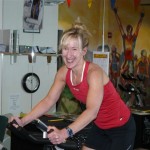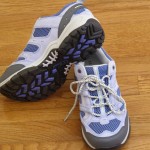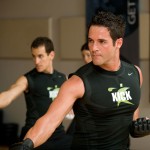by Michelle Sutton-Kerchner
Being part of a fitness community reinforces a sense of solidarity in obtaining your healthiest life. Strengths, weaknesses, insecurities, curiosities —we come to recognize them as shared. We aren’t alone. With this validation, we have the courage to travel in new directions, reach beyond expectations, and pose a few questions …
We’re told all our lives that stupid questions do not exist. In actuality, many of us share similar concerns. After interviewing the Center’s personal trainers and fitness instructors, here are some members’ top concerns and curiosities. Chances are—you’ve been wondering the same thing.

If I lift heavier weights, will I get bulky big?
No. If you’ve ever talked to anyone who has tried to “get big,” it is seriously hard work. Fitness Manager Sharon Casper notes this seems to be a concern of women. In general, women’s lower testosterone levels prohibit them from obtaining a hulk-like build. Sharon recommends lifting heavier weights, with fewer repetitions, which builds lean muscle mass and boosts metabolism.
I had great results with my workout, but lately it seems ineffective.
You’ve hit a plateau. Change it up and make progress! Sharon describes the body as “a very efficient machine.” After a while, it becomes accustomed to whatever you do, rendering the activity ineffective. Periodization is a training method that organizes varied exercises into categories, and cycles them over a period of time. Originally designed for athletes to prepare for their sport season, others can also benefit by changing the intensity, type, and volume of training throughout the year. Be in peak shape for the game of life!
What is the difference between chronic and acute pain?
Acute pain is usually provoked. Dropping a shovel on your toes triggers acute pain. Incorrectly shoveling snow with that shovel can lead to chronic pain. For example, chronic pain can be the result of an injury that triggers long-term inflammation.
By definition, chronic pain lingers for more than six months, varying in intensity but not persistence. Acute pain is given high priority in nerve signal transmission to the brain. This immediacy prevents the offending action from recurring by warning of acute danger.
Scientists continue to struggle with understanding the nature of pain. They study the types of nerve fibers involved in the transmission of pain, how those signals get to your brain, and how the information is processed. As information is gathered, and the nature of pain is further understood, one fact remains clear: Exercise is an important aspect of treatment.
Intervals of rest are necessary, but inactivity deconditions the body, which may exacerbate chronic pain. A personal trainer can provide insight on the safest, gentlest movements for those suffering physical distress.

Is it better to achieve weight loss through cardio or resistance training?
Combine both cardio and resistance training. Often, people forget to include resistance training in their weight-loss routine. However, building lean muscle mass helps burn fat. Simplified, weight loss is a mathematic equation of calories consumed verses calories expended. Along with any exercise program, a healthy diet is essential. This is particularly true for weight-loss goals.
Personal Trainer Liz LaFavor suggests a workout three times a week or more that incorporates resistance training and a 20-minute minimum cardio workout. She emphasizes systematically changing your routine every six to eight weeks to avoid a plateau. Do this and experience results in a safe, effective manner.
Toning shoes: gimmick or godsend?
According to Liz, “If a product seems too good to be true, it usually is.” Such is the case with toning shoes, which promote the idea of getting fit by going around living your normal life in these sneakers.
“When wearing such shoes, your body is thrown out of neutral alignment. Your hips are put into an anterior pelvic tilt, which puts a significant strain on your lower back and knee joints,” informs Liz.

An independent study sponsored by the American Council on Exercise indicated toning shoes did not result in improved calorie burning or muscle activation. Participants in traditional sneakers performed statistically equal in these tasks. For more on these and other shoe trends, see “If the Shoe Fits, Should You Wear It?” (F&W News August 2010, www.fitnessandwellnessnews.com/health/if-the-shoe-fits-should-you-wear-it/).
My joints crack and pop so much, I sound crunchy. Am I arthritic?
The association between arthritis and joint cracking is largely mythical. Inadvertent, painless popping of a joint is common and tends to be harmless. It can be the result of bones rubbing together or bones of a joint becoming fixated.
When two bones rub together, the temporary friction produced vibrates when released, which causes a popping sound.
Joint fixation occurs when bones of a fixated joint are temporarily stuck together. The popping is heard when this suction breaks. There is no friction involved.
The ends of bones are lined with hard, smooth cartilage; the joint itself is filled with synovial fluid. This fluid lubricates the joints and minimizes friction. If a joint is immobile long enough, some of the fluid between the bones seeps out and a temporary vacuum, or fixation, occurs. This explains the cracking we hear upon waking in the morning during a good stretch.
Releasing a fixation can be helpful in joint functioning. It’s like releasing a build-up, which won’t reoccur until the joint is rested and immobile at length. However, repetitive friction popping can be harmful, and even habit forming.
During chiropractic treatment, you’ll often hear cracking or popping as your joint is manipulated. The goal is to relieve pain and improve the body’s functioning, mainly through adjusting the nerves surrounding the spinal cord. Methodically applying force to a joint through hand pressure, the chiropractor can push beyond the normal range-of-motion, causing a cracking sound.

I sweat profusely during exercise. Does this mean I’m still out of shape?
No. Sweating during exercise signals quite the opposite. Those in top shape, including professional athletes, sweat. Sweating indicates the body’s ability to cool efficiently. As the body adapts to keeping its core cool during a workout, blood is delivered to the skin’s surface more quickly, which releases heat. Sweat glands work to release their output and cool the body through the perspiration process. Fit people actually produce more sweat than their sedentary counterparts. They also lose less sodium because more is reabsorbed by the body.
I can’t seem to build muscle. Should I increase my protein intake?
Not necessarily. Suzanne Nelson Steen, head of the University of Washington Huskies Sports Nutrition Program, notes strength training requires only slightly more protein than any other. Muscle contractions are fueled by carbohydrates, which should be consumed daily to restore glycogen levels. Adequate carbohydrates are needed to replenish muscle glycogen.
Eat a well-balanced diet and consult with a personal trainer for a bodybuilding workout customized to your needs. There are no shortcuts, despite how tasty protein bars are these days.
Solutions Abound
At the Center, enjoy the diversity present in this community of fitness and wellness. We all travel from different backgrounds; share unique experiences; and have our own gifts, talents, and specialties. If you’ve thought of it, someone’s probably done it. In solidarity, we have answers to each other’s questions and journey farther because of it.
Sources
“Chiropractic Adjustment,” at www.mayoclinic.com.
“Cracking and Popping Joints,” by Paul Grilley at www.yogajournal.com.
“Fitness Myths and Half-Truths,” by Elizabeth Quinn at www.sportsmedicine.about.com.
“The Pain Truth: How and Why We Hurt,” by Robert Roy Britt at www.livescience.com/600-pain-truth-hurt.html.
Image Credits
Puzzled (introductory photo): www.flickr.com/photos/georgesipl/3235525414
 Fitness & Wellness News Your Source for Fitness News, Wellness News, Health News, and Nutrition News!
Fitness & Wellness News Your Source for Fitness News, Wellness News, Health News, and Nutrition News!



